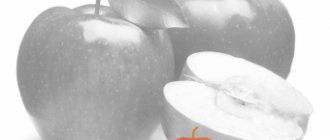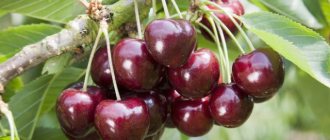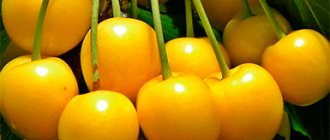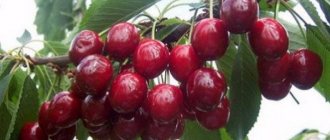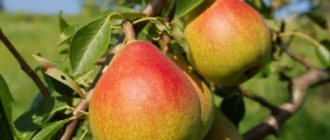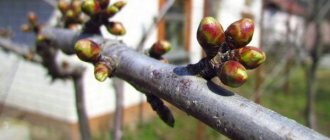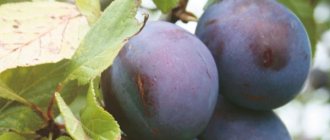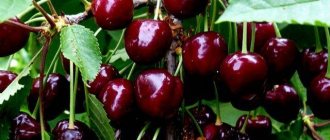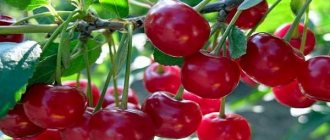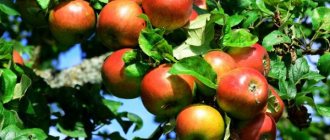Caring for Orlovskaya pink cherries
To obtain a high yield, it is important to provide the cherries with the necessary care.
During the season, the tree is watered and fed with useful substances. The crown is formed using pruning.
Feeding and watering
Cherries begin to be fed a couple of years after planting. If fertilizers were applied to the pit, then their supply is sufficient for the development of the seedling. In the future, fertilizing is carried out annually. The culture reacts positively to the supply of nitrogen substances. In early spring, it is watered with an infusion of cow manure or a urea solution (30 g per 10 liters of water). At the beginning of fruiting, prepare a solution of superphosphate and potassium salt (30 g of each component per 10 liters of water). In the fall, dig up the soil and add 10 kg of compost, 90 g of phosphorus and 40 g of potassium fertilizer.
Cherry is a moisture-loving crop that is watered 3-4 times per season. 5 buckets of water are added to young trees; adults need up to 12 buckets. Trees need moisture when buds open, before fruiting, and in the fall during preparation for winter.
Weeding and loosening
After watering, loosen the soil so that moisture does not stagnate in the soil. As a result, the soil is saturated with oxygen, and cherries better absorb moisture and minerals. The soil is loosened to a depth of 10-15 cm. Be sure to clear the tree trunk circle of weeds.
Crown formation
Pruning helps stimulate the growth of new strong shoots and produce high yields of cherries. It is carried out in spring or autumn, when the sap flow of the cherry slows down. The Orlovskaya variety forms a tiered, sparse crown. The process takes about 5-6 years. Each tier consists of 3-5 shoots located at a distance of 15 cm. The remaining branches are cut out. About 50 cm is left between individual tiers. In total, it is enough to form 3-4 such tiers. Every year, preventative pruning is carried out: old, dry, frozen and diseased shoots are removed. The top is trimmed to a height of 3.5 m.
Pollinators of the Orlov pink cherry
The variety Orlovskaya rosea is self-sterile. A prerequisite for obtaining a harvest is the presence of pollinators. They are planted at a distance of 3-4 m from each other. For the formation of ovaries, it is necessary that the trees bloom at the same time. It is recommended to choose zoned varieties. For example, the Orlovskaya Amber cherry with yellow fruits is suitable for planting in the middle zone.
Best pollinators:
- Poetry. The dessert variety ripens in the middle period and bears dark red fruits. The flesh is gristly, sweet and sour. The variety is relatively resistant to fungal diseases and winter frosts.
- Pink pearls. Large-fruited variety, average weight of cherries is 5 g. The fruits are pink-orange with a red tan. The taste is sweet, the yield is stable. Sweet cherries are little susceptible to fungal infections.
- In memory of Chernyshevsky. A tall, fast-growing tree that bears rich red fruit. The pulp is tender, sweet and sour, taste rating is 4.8 points. Winter-hardy variety with high yields.
- Orlovskaya Amber. A cherry variety with good yield and resistance to coccomycosis. The fruits are large, sweet, yellow in color.
Cherry 'Amber'
Latin name: prunus avium 'yantarnaya'
Main type: Cherry
| Fruit size |
|
| Fruit shape |
|
| Fruit color | |
| Winter hardiness |
|
| Decoration of plants and fruits |
|
| Flower size |
|
| Brush characteristics |
|
| Berry/truss separation |
|
| Nut kernel size |
|
| Blush (cover color) |
|
| Fruit pulp color | |
| Density and character of the pulp (fruit/bush/yag) |
|
| Fruit aroma |
|
| Frost resistance (fruit/bush/yag) |
|
| Drought resistance (fruit/bush/yag) |
|
| Beginning of fruiting after planting |
|
| Ripening period (fruit/bush/yar) |
|
| Consumer maturity |
|
| Productivity (fruit/bush/yag) |
|
| Fruit shedding |
|
| Remontant |
|
| Self-pollinating/self-fertile |
|
| Purpose of fruits (fruit/bush/yag) |
|
| Taste of fruits (fruit/bush/yag) |
|
| Soil pH requirements (fruit/bush/yag) |
|
| Shelter for the winter (fruit/bush/yag) |
|
| Soil type (fruit/bush/yar) |
|
| Disease resistance (fruit/bush/yag) |
|
| Resistance to pests (fruit/bush/yag) |
|
| Habitus (fruit/bush/yag) |
|
| Growth form |
|
| Crown density |
|
| Thorns, thorns |
|
| Vitamin content (fruit/bush/yag) |
|
| Keeping quality of fruits (fruit/bush/yag) |
|
| Cultivation region by origin (fruit/bush/yar) |
|
Expand all properties
Description of the plant:
Cherry 'Amber' is the result of crossing the varieties 'Drogana yellow' and 'Gaucher'. Obtained from the State Nikitsky Botanical Garden. Accepted for state testing in 1948.
The variety was included in the State Register in 1989 for the North Caucasus region (Chechen and Ingush Republics).
Dimensions and growth form:
The 'Yantarnaya' variety is represented by vigorous trees with a dense, spherical crown.
Flowers and fruits:
The fruits are quite large, weighing 5–6 g, blunt-round in shape, even. The skin is golden yellow, with a pink blush.
The pulp is creamy, medium density, gristly, juicy. The taste is very good. The bone is separated.
The purpose of the fruit is universal.
Precocity, ripening time, yield:
Cherry 'Amber' is a medium ripening variety. The yield is plentiful. Precociousness is high.
Description and characteristics of the variety
Oryol amber cherry is an early ripening fruit crop, the height of an adult tree reaches 4 meters. The peculiarity of this variety is the color of the berries. So, the usual color of cherries is pinkish or red, but this variety has an amber-yellow hue.
Around June 10, gardeners can already harvest. It is quite well adapted to weather changes. The berries ripen successfully both in hot, dry seasons and in rainy seasons. The skin is not prone to cracking. Exposure to moisture is practically zero.
Description of the tree
The crown of this fruit tree variety is medium dense, spreading and slightly raised. Its size is slightly larger than average. The shape of the crown is pyramidal and raised upward, the density is average, and the branches are slightly drooping. The main shoots are of medium length, bare, straight, not pubescent.
Important! Such cherries do not tolerate loneliness and for their productivity the presence of nearby pollinating trees is necessary. Other fruit flowering and at the same time self-fertile varieties should grow nearby.
The bark on the trunk and main branches is matte, grayish in color. Oval-shaped leaf, emerald green. The petioles are 4.5–5 mm long and 2.8 mm thick. It blooms with lush white inflorescences. It bears fruit on so-called “bouquet” branches and fruit twigs.
For example, it is recommended to plant cherries near other varieties that bloom at the same time. Fertilization will occur when pollen falls on a self-sterile cherry.
Description of fruits
Ripe berries are amber-yellow in color, heart-shaped, weighing approximately 3.6 g with a pointed tip. Near the petiole the shape is slightly rounded. The pulp is dense, juicy, sweet, without sourness. The sugar content in ripe berries is no more than 10%, and the acid content is no more than 0.5%. The smell is aromatic, the juice is light. The berry is slightly larger than average in size and weighs approximately 5.5–6 g.
The advantage of yellow-fruited cherries is that their fruits do not attract birds. They do not peck ripe berries, which allows them to preserve the harvest. The weight of the stone is 0.2 g (average size), which is 5.6% of the specific weight of the fruit. In ripe berries, it separates quite well from the pulp.
Productivity
From mid-June, gardeners begin to harvest. Approximately 33–35 kg of ripe berries can be harvested annually from one tree. Thus, the yield will be 80–120 c/ha. In the 4th season, after the seedlings are planted in the ground in a permanent place, the tree begins to bear fruit. Already in the second half of May, buds appear on the branches. Harvesting occurs from the second half of June to the second half of July.
Frost resistance
This cherry variety has maximum frost resistance and high biological potential for winter hardiness. Generative buds are not damaged by frost at -20°C. This variety can be grown in many regions with different climates (short summers, cold winters). However, the tree may not overwinter well and may produce shoots higher than the grafting, so it would not be a bad idea to cover the roots of the trees with snow in frosty weather.
Important! The most harmful influence on the stability of the Oryol amber cherry is caused by severe frosts in the middle of winter, as well as spring frosts after a thaw.
Every gardener would like to regularly receive a good harvest of Oryol amber cherries. By following the rules for planting it and taking into account the technology for further care, you can get the desired result.
Description of the variety
In order for a fruit crop to bear fruit abundantly, you need to know the basic parameters and characteristics.
Height of an adult tree and branching of the crown
Amber cherry belongs to the category of medium-sized plantings, its height does not exceed 3-4 meters. The crown is quite spreading, drooping, with medium foliage. The shape of the cherry is Amber, wide-pyramidal, the length of the main shoots is medium, there is no pubescence, the color is yellow. The color of the bark of the main conductor and side branches is gray, the surface is smooth.
The leaf apparatus of the Amber cherry is distinguished by a light emerald hue, the plates have an oval shape. The petioles are short, their length is up to 5 centimeters. The formation of ovaries occurs mainly on bouquet branches. White flowers are formed of medium size, the number of petals is five.
Upon reaching consumer maturity, the color of the fruit becomes amber, sometimes with a pink tint. Their shape is similar to a heart with a pointed upper part, the average weight is 5-6 grams. Yantarnaya cherries begin to bear fruit 4 years after planting in a permanent place. Not only the skin, but also the pulp has an amber tint, it is sweet with a pronounced aroma, the sourness is not noticeable.
The sugar content of Yantarnaya cherries is almost 10%, and the acidity is 0.5%.
All about pollination, flowering and yield
Since the Yantarnaya cherry belongs to self-fertile plants, to increase performance indicators it is recommended to plant pollinating varieties such as Vityaz, Ovstuzhenka, Severnaya, and Iput nearby. The flowering phase of this variety occurs in the second half of May, and the fruit ripening phase occurs in late June and early July. Under favorable growing conditions, the yield of Yantarnaya cherries is, on average, 35-37 kilograms per planting.
Transportability and use of berries
The fruits of the Amber cherry, when consumed regularly, are a good preventive measure for various ailments, and also help normalize digestion and improve blood composition. Their juice is clear, the pulp is tender and tasty. The harvest is actively used for preparing winter preparations and culinary masterpieces. Amber cherries are not suitable for transportation over long distances.
How to propagate the variety
To get a new plant, gardeners use one of the following methods:
- Grafting method. In this case, cuttings with two buds are used, which are harvested in the fall, and a rootstock - shoots, seedlings. Copulation should be done 1-2 weeks before sap flow, making oblique cuts up to 5 centimeters on both the rootstock and cuttings. In addition, you need to make an additional cut (up to 1 centimeter). After joining the two components, the junction is wrapped with tape or adhesive tape.
- Cuttings. The length of the Yantarnaya cherry blanks should be 30 centimeters; their cut parts are kept in a solution of a growth stimulator for 12 hours, and then placed in greenhouse conditions, buried 3 centimeters. The distance between the cuttings should be 5 centimeters; a soil mixture is used from equal parts of peat and sand. Caring for them consists of regularly moistening the soil and maintaining the temperature within 25-30 degrees. The formation of roots in the Amber cherry will occur after 3 weeks.
- Seed method. It is more labor-intensive, but quite possible.
Cherry processing Amber
Regular treatments of the Yantarnaya variety will help avoid the development of diseases and the spread of pests. Prevention begins in early spring before sap flow begins. Add 70 g of urea to 10 liters of water. Trees are sprayed with the resulting solution.
It is important to avoid contact of the liquid with the kidneys as urea causes a burn
Attention! Folk remedies are used for preventive purposes. To treat cherries, infusions are prepared from wood ash, tobacco dust, onion and garlic peels. To protect the Yantarnaya variety from diseases, it is sprayed with a solution of the fungicide Karbofos, Antilin or Nitrafen
Treatments with Fitoverm, Iskra-bio, and Agravertin are effective against pests. To increase the resistance of the variety to unfavorable conditions, spraying with Zircon is practiced. In the autumn, after leaf fall, the cherry processing is repeated.
It is important to irrigate if trees have been exposed to diseases or pest attacks.
To protect the Yantarnaya variety from diseases, it is sprayed with a solution of the fungicide Karbofos, Antilin or Nitrafen. Treatments with Fitoverm, Iskra-bio, and Agravertin are effective against pests. To increase the resistance of the variety to unfavorable conditions, spraying with Zircon is practiced. In the autumn, after leaf fall, the cherry processing is repeated.
It is important to irrigate if trees have been exposed to diseases or pest attacks.
Pests and diseases
Amber cherry, like any other garden tree, can become a victim of disease or harmful organisms. The yield suffers from this, and the plant itself may die.
This varietal variety of cherries is more often affected by diseases such as white rust and cylindrosporiosis. The most common pest is the cherry fly, the larvae of which cause worms in the fruit.
Timely preventative treatment will help to protect plantings. It must be done twice a year. The first is in early spring, before the process of sap movement in the tree begins. The second time, prevention is carried out in the autumn season, during the fall of the leaves.
A urea solution is effectively used as a prophylactic material. To prepare it, 700 g is diluted in 10 water. The entire tree is treated with the resulting solution.
How to plant
To grow a healthy, fruit-bearing tree, you need to choose high-quality seedlings and correctly determine the place and timing of planting the fruit crop.
Recommended timing
Cherry seedlings are planted in accordance with climatic conditions. In the south, planting work is recommended to be carried out in the fall. In regions with a temperate climate, trees are planted in early spring, before the start of the growing season.
Selecting a location
Sweet cherries of the Yantarnaya variety are placed in well-lit, flat areas or small hills, protected from cold winds and drafts.
The height of groundwater should not exceed 2-2.5 m. Otherwise, the rhizome of the tree will quickly rot and the seedling will die.
The fruit crop is grown in fertile, loose soils with neutral acidity and humidity.
Heavy, clayey soil is mixed with river sand and humus or compost. Acid soil is limed.
Preparing the planting hole
Preparation of the planting pit begins 3-4 weeks before planting the seedlings.
- The selected area is dug up deeply, cleared of weeds and loosened.
- Humus, mineral and organic fertilizers are added to the soil.
- Planting holes are dug in the prepared soil.
- The depth and width of the hole is from 70 to 90 cm, the distance between plantings is from 1.5 to 2 m, between rows is 4-5 m.
- A thick drainage layer of sand and small stone is laid at the bottom of the hole.
- Fertile soil mixture is poured on top and watered.
Important! A support peg is placed in the center of the hole to support the seedling.
How to select and prepare planting material
Seedlings of varietal and hybrid cherries are purchased in nurseries or specialized stores
2-3 year old plants take root and take root best. The trunk of the seedling has no obvious damage, no fungal infections, smooth and monochromatic, with numerous branches. Each branch must have buds or green leaves. When examining the rhizome, pay special attention to moisture. The roots should not be overdried. The roots are free of any damage, plaque, or signs of rot or fungus. In the lower part of the tree there should be a mark from the grafting, by which you can determine whether the cherry belongs to the varietal varieties
Lack of grafting indicates that the plant is wild
At the bottom of the tree there should be a mark from the grafting, by which you can determine whether the cherry belongs to the varietal varieties. The absence of grafting indicates that the plant is wild.
Requirements for neighbors
Sweet cherries of the Yantarnaya variety do not tolerate the proximity of other trees, with the exception of varieties of pollinating fruit crops, or cherries.
Berry bushes, flower beds, garden strawberries, rowan or hawthorn are planted next to the cherries.
It is not recommended to grow raspberries, gooseberries, or any plants from the nightshade family next to cherries.
Planting scheme
Before planting, seedlings are placed in a container with warm, settled water for 10-15 hours and treated with preventative agents to protect against the spread of fungus and viruses.
- The plant is placed in the prepared planting hole.
- The roots are evenly distributed over the hole and covered with fertile soil, leaving no voids between the roots and the soil.
- The soil under the plant is compacted and watered abundantly.
- The seedling is attached to a support peg and trimmed.
After planting, the tree trunk circle is mulched with humus or dry grass.
How to plant Yantarnaya on the site
In order for seedlings to take root faster and adapt to new conditions, you need to know how to plant and care for them correctly.
Choosing a healthy and strong seedling
It is recommended to purchase planting material from nurseries or at exhibitions. They should not contain signs of disease, traces of rot, or various types of damage. It is better to plant a plant with one central trunk and a healthy root system. Their age should be 1-2 years. The dried roots are kept in a container with water for three hours.
Recommended timing and planting pattern
When grown in regions with a warm climate, planting should be done in the fall, when the leaves have fallen from the trees. But for Central Russia, the best period is spring. To plant Yantarnaya cherries, choose clearings that are well-lit and protected from draft winds, where the depth of groundwater should be from 1.5 to 2 meters. The distance between plantings should be 4-5 meters.
Pit preparation and planting technology
The landing site should be prepared in advance, 2-3 weeks in advance. The soil mixture for filling the pit consists of two buckets of extracted soil, 500 grams of wood ash and 180 grams of superphosphate. Alternatively, you can use a special complex fertilizer. The technology for planting a Yantarnaya cherry seedling in a permanent place involves performing the following actions:
- Digging a pit 90-100 centimeters deep and 80 centimeters wide.
- Laying on the bottom a drainage cushion made of expanded clay, broken brick, small crushed stone (layer thickness - 7-10 centimeters).
- Filling the hole with a nutrient composition (layer thickness - 10-15 centimeters).
- Installing a wooden peg closer to the center of the hole to secure the seedling.
- Placing a young plant and spreading its roots on different sides.
- Backfilling and compacting soil.
- Abundant watering and mulching.
Landing Features
Cherries should be planted next to at least 2-3 trees of different varieties, with the same ripening periods. The proximity to cherries is useful, since cherry pollen perfectly pollinates cherry inflorescences.
Selection of seedlings
It is better to buy seedlings in nurseries or from trusted sellers in the fall. At this time there is a greater selection of planting material. If you buy it from unscrupulous breeders, there is a risk of getting a wild seedling or the wrong variety. Planting material must be visually inspected for damage, rotten areas, mold and other deformations.
The required length of the seedling should be up to 1 meter. It must have a powerful conductor, several branches. If the root system is dry, it needs to be kept in clean water. The seedlings should be 1-2 years old. The trunk is dark beige in color, with a grayish undertone. There must be a vaccination site on it. This indicates the authenticity of the variety and the health of the seedlings.
Choosing boarding time and location
In the South, cherries are widely planted in the autumn, when leaf fall ends. 3-4 weeks before frost, the seedling has time to develop a rhizome. In mid-latitudes or in the North, planting work is postponed until the spring, when the snow melts and the buds begin to swell.
This is by no means the most frost-resistant variety of cherries; it is advisable to plant the tree next to buildings, for example: next to a barn or bathhouse, a fence, a house. The place on the plot should be sunny, covered on the north side by a brick wall. When it heats up, the tree will not only be protected from the cold, but will also warm up.
The variety does not like water stagnation. If there is a risk of tree flooding on the site, it is better to build drainage or plant it on a hill. Otherwise, the seedling will develop poorly or die. The groundwater level should be from 1.5-2 meters.
Pit preparation
When preparing the land, it is important to take into account that horizontal roots lie at a level of 30-80 cm from the surface, and vertical roots are deepened by more than 2 meters. It’s worth not just digging a hole, but plowing where the planting site is planned
The normal size of the pit is at least 80 cm deep, approximately 1 m wide. Plant seedlings at a distance of 3-5 meters from each other. The trees should be provided with space, or the spreading bush will shade and suppress other plants.
Landing
Before planting, you need to prepare the earth mixture. It consists of 2 buckets of soil, 1.5 kg of ammonium sulfate, 1 kg of superphosphate, 1 liter of potassium. Add 3 buckets of humus to the combination. Apply fertilizer to the planting hole. Plant the seedlings in holes 75*90 cm. Before placing the tree in the hole, straighten the rhizome, then tie the trunk to the support peg. Fill the hole with soil without covering the rhizome. Water the soil around and mulch.
Features of cultivation and care
To grow a tree that will bear fruit well, you need to take into account the following subtleties of caring for Drogana Yellow.
Selection of location and planting material
The place where you plan to plant the cherry seedling should be sunny. Drogana Yellow prefers neutral or slightly acidic soil. The soil for planting should be light sandy or sandy loam.
Important! In order for the Drogana Yellow cherry to develop normally, it needs periodic liming of the soil. Since moisture stagnation is undesirable for this variety, it should not be planted in low-lying areas
The distance from groundwater must be at least 2 m
Since moisture stagnation is undesirable for this variety, it should not be planted in low-lying areas. The distance from groundwater must be at least 2 m.
When choosing planting material, you should pay attention to the following factors:
- seedling age. The seedling must be about 3 years old;
- presence of documents or tags on the seedling. It is best to buy a plant in a special nursery;
- root. It must have at least three branches;
- the presence of generative buds.
Planting scheme
Trees of this variety should be planted in the spring (before the buds swell) or in the fall (a month before the expected cold weather).
Important! Before planting, it is necessary to remove leaves from the seedling so that they do not take moisture from the plant. To avoid mistakes in this process, you need to follow simple instructions:
To avoid mistakes in this process, you need to follow simple instructions:
Dig a hole whose dimensions are 80x80x70 cm. It should be at a distance of 4-5 m from other plants. Remove the top fertile layer and add compost or humus there in a 1:1 ratio. For drainage, pour lime gravel into the hole. Pour a bag of dolomite flour onto the gravel, which will reduce the acidity of the soil and increase the calcium content in it. Place the seedling in the planting hole and dig a peg next to it, then fill it with soil. Compact the soil around the seedling to form a watering hole
In this case, you need to pay attention that the root collar is above the ground level. Tie a seedling to a stake
Water thoroughly until water is no longer absorbed into the soil. Mulch the tree trunk using rotted sawdust or dry peat.
Watering and fertilizing
One of the conditions for proper plant care is its regular and proper watering. The young plant must be firmly rooted, so for a month after planting, it is necessary to water 2 times a week at the rate of 10 liters of water per tree.
Subsequently, during the season, cherries need to be watered 3-4 times a season, especially during flowering and ripening of the crop. 50–70 liters of water should be poured under each mature tree.
It is good to combine watering with fertilizing. In spring, 20 g of urea, superphosphate and potassium salt should be added to 10 liters of water. In summer, fertilizing should be done without urea and nitrogen-containing substances. Once every 3 years, you need to dig up the soil in the tree trunk circle and add up to 10 kg of humus per 1 m².
Pruning and crown formation
For the full development of Drogana Yellow, its crown should be trimmed periodically. After planting, cherries need to be pruned for the first time after 1-2 years at the beginning of summer. To do this you need:
- if the seedling has 4–6 branches, the lower branches need to be cut to 50 cm, and the upper ones should be reduced by half;
- If the tree has up to 3 branches, they should be cut to 25 cm.
Pruning should be done in spring or autumn when sap flow slows down in the cherry tree. Sick, broken, frozen branches should be trimmed without fail.
In the first 5-6 years after planting, the cherry tree needs to be formed. To do this, it is necessary to cut the central conductor and shoots by a third of the length. Every year you need to form a new tier.
Preparing trees for winter
To protect Drogana Yellow from frost, in the fall you need to prepare it for wintering, for which you will need:
- Water the cherries generously. The moistened soil will slowly freeze, thereby protecting the tree from the cold.
- Hill up the trunk and mulch the soil with humus.
- Cover young plants with burlap or spruce branches. After snow falls, a snowdrift is formed from it and thrown over the cherry tree.
- To protect the trunk of Drogana Zheltaya from rodents, it should be covered with a casing made of tin, metal pipe or roofing felt.
Agricultural technology
When planting Amber cherries, it should be taken into account that for its pollination and fruit set, the planting of other varieties of this tree is required. The optimal varieties will be Vityaz, Gostinets, Iput, Ovstuzhenka and Severnaya.
When cultivating this species in the northern regions of the country, it is important to keep in mind that while the tree is highly frost-resistant, the flower buds do not tolerate frost well, which can affect the yield. The timing of planting cherries in open ground depends on the region: in the southern parts of the country it is planted in the fall, in the middle zone - in the spring
The timing of planting cherries in open ground depends on the region: in the southern parts of the country it is planted in the fall, in the middle zone - in the spring.
The tree prefers fertile soil that is not prone to waterlogging. Light loamy soils that are highly permeable to oxygen are most suitable for it. A soil mixture of soil, ammonium sulfate, superphosphate, potassium fertilizers, wood ash and manure is added to the planting hole. If the soil is clayey, additional sand is added to it.
Landing
The planting process does not have any special features: the soil is dug up, a hole is dug, it is filled with a pre-prepared soil mixture, a seedling is placed in the hole and the root system is covered with soil. The root collar is not buried, but is left slightly above the soil surface. The trunk of the tree is tied to a peg, the circle around the trunk is watered and mulched.
Cherries grow best in windless, sunny areas or in partial shade. To prevent trees from shading each other, the distance between them should be from 3.5 to 5 m. Gardeners do not recommend planting seedlings in close proximity to water bodies.
The proximity of this crop to other fruit trees, for example, apple, apricot, and pear, should be avoided, since they have diseases in common with cherries. Experienced gardeners have noticed that the currant plantings located near Orlovskaya are dying.
Rules of care
Caring for Amber cherries is not very difficult. She needs:
- weeding and loosening;
- watering;
- pruning;
- fertilizing with mineral and organic fertilizers;
- prevention of diseases and pests;
- shelter for the winter in severe frosts.
For good growth, the root system of cherries requires access to oxygen, so it is important to destroy weeds in a timely manner and loosen the soil around the trunk
In a normal summer, cherries are watered 3 times; during prolonged dry weather, the frequency is increased. You can water the tree with either settled or running water.
Tree pruning is done in March, before sap flow begins. The main purpose of removing dry, weak and broken branches is to prevent thickening of the crown and a decrease in yield. To prevent the tree from becoming infected with fungal diseases, the cut areas must be treated with garden varnish.
If a soil mixture was added to the hole when planting, then fertilizing can be done no earlier than 4 years later, when the tree enters the fruiting phase. Mineral fertilizers are applied in mid-summer, and organic fertilizers are applied at the end.
The Amber cherry variety is relatively resistant to some diseases, but trees can be affected by white rust and cylindrosporiosis. The cherry fly is also a danger.
To prevent diseases and pests in early spring and during autumn leaf fall, trees are treated with a urea solution (700 g of urea is added to 10 liters of water).
Despite the fact that the variety is frost-resistant and can withstand temperatures down to -30 °C, it is recommended to cover the root circles with snow.
Thanks to such characteristics as frost resistance, immunity to common diseases and unpretentiousness, Orlovskaya Amber Cherry continues to gain popularity among gardeners, and the yellow or pink berries, unusual for this crop, and their sweet taste and aroma are liked by both children and adults.
If you follow simple rules for caring for this variety, cherries will delight you with a rich harvest for many years.
Description of the Ovstuzhenka variety of cherries
Cherry belongs to the southern crops. But, thanks to the work of breeders, cherry trees also appeared in cooler regions of Russia. In 2001, a new variety called Ovstuzhenka was added to the State Register of Russia for the Central region. Authorship belongs to M.V. Kanshina, who developed a new product by hybridizing previously known varieties - Leningradskaya Chernaya and Compact Venyaminova.
Ovstuzhenka cherry is included in the State Register of Russia for the Central region
Cherries grow very quickly, but are compact in size, which makes harvesting much easier. Growth stops when the tree begins to bear fruit, that is, after 4 to 5 years. The shoots are medium thick, covered with red-brown bark and grow straight. Their quantity is average, so the inside of the tree is not very thick. The crown is slightly raised and has a spherical shape.
Ovstuzhenka cherry is small in size
The shoot bud has the shape of a cone, strongly deviated from the branch. Floral - similar to an egg, but with a pointed top. The kidney size is large. The inflorescence consists of 3 large flowers. Fruit ovaries form on bouquet branches.
The leaves are large, ovoid in shape with a sharply pointed apex and a rounded base. They have serrated edges. The leaf blade is flat, dark green, with a matte surface. Petioles are short, of medium thickness.
Ovstuzhenka is the owner of large fruits, weighing up to 7 g. The berries are very attractive in appearance - round-oval in shape, dark red, almost black in color and glossy. The pulp is medium dense, very juicy and sweet. Taster rating: 4.7 points. The juice, like the pulp, is dark red in color. Severing the berry from the stem is dry.
Ovstuzhenka cherry fruits are large and beautiful
Birds love ripe cherries.
The light brown stone has a mass of 0.27 g, which is approximately 6.4% of the total mass. It separates from the pulp easily.
What benefits do fruits have?
For children, cherries are undoubtedly one of the most delicious berries, bringing great benefits to growing organisms. It is full of valuable vitamins and microelements. Cherries will also bring a lot of benefits to adults. It will strengthen blood vessels, prevent the development of anemia, and improve liver and kidney function. Ovstuzhenka berries, colored dark red, will help with heart and blood diseases. In addition, the fruits prevent the development of tumors.
Cherries will also help people who are overweight. It has a diuretic effect and helps remove excess fluid.
But there are also contraindications. For people with acute forms of ulcers and gastritis, as well as those suffering from diabetes, sweet berries are not recommended.
Delicious cherries bring great benefits
Distinctive features
- The earliest flowering period is mid-May.
- Ovstuzhenka cherry fruits do not crack even in very wet weather.
A distinctive feature of the ovstuzhenka cherry is its early flowering.
Features of culture
It was developed by Bryansk scientists M.V. Kanshin and A.I. Astakhov in the early 90s. The goal they pursued was to create a cherry tree with high frost resistance and tasty fruits. The need was due to the fact that the cherry itself is a very sensitive tree to temperature changes, which could not grow in cold climates.
This is how Iput turned out, its features made it possible to grow cherries in central Russia and even in the latitudes of St. Petersburg. Sweet cherries were included in the register of breeding achievements of the Russian Federation in 1993.
Plant characteristics
The Iput variety will be immediately noticeable against the background of low-growing trees: its growth reaches up to 5 m in height.
Cherry Iput is distinguished by the following indicators:
- the crown of the tree is wide-pyramidal, up to 5 m in diameter;
- the leaves are dark green, slightly elongated and pointed at the tips;
- inflorescences consist of 3-4 white flowers, closely touching each other;
- the buds are large.
The tree is distinguished by its high productivity. From one Iput cherry you can collect up to 30 kg of berries, and with careful care, up to 50 kg. The arrangement of the inflorescences allows you to harvest without difficulty. Cherry fruiting begins 5 years after planting.
Iput blooms in mid-May, and the fruits ripen by the end of June. The variety, despite its frost resistance, may not withstand sudden temperature changes during bud break.
Iput is a self-pollinating tree, but good pollinators are needed nearby, then you can get a good harvest. The following varieties are best suited: Tyutchevka, Bryansk pink cherry, Ovstuzhenka, Trosnyanskaya, Raditsa.
Cherry Iput is also a universal pollinator for all varieties of cherries.
Fruit
Description:
- heart-shaped berries, weighing 5-9.7 g;
- ripe berries are almost black;
- the fruit is held on the branches by short thick stalks;
- a small egg-shaped bone;
- the pulp is medium density, dark red, sweet with a bitter aftertaste;
- The pulp is difficult to separate from the stone.
The Iput cherry variety lends itself well to transportation, but is not designed for long-term fresh storage, like all other varieties of cherries. The fruits are used to prepare compotes, jams or juices, but it is more advisable to eat them fresh. This way you can get all the useful microelements.
Cherry Iput contains:
- dry matter - 15.6-16.6%;
- sugar - 11.0-11.7%;
- acids - 0.5-0.73%.
Reviews from summer residents about Yantarnaya
Cherries are popular among gardening enthusiasts. She has proven herself exclusively on the positive side.
Anna, 56 years old, Saratov:
“Yantarnaya pleased me with its unusual and tasty fruits. Taking care of her is a pleasure. The frost resistance of the variety is quite sufficient for our climate.”
Andrey, 45 years old, Moscow:
“There are no disappointments with the variety, I am very glad that I purchased it and have already managed to enjoy the fruits. For cherries, the main thing is to choose a suitable place and care for them correctly.”
Amber cherry belongs to the category of large-sized plants. The main feature of this variety is the bright color of the fruit, amber-yellow.
Planting cherries
Proper and timely work on planting Bryanochka cherry seedlings is the key to obtaining a large harvest of tasty berries in the future.
Optimal timing
The planting time depends on the climatic conditions of the region in which the tree will grow. In warm southern climates, planting work is carried out in the fall. Young seedlings have time to take root and easily tolerate mild winters.
But in the central zone of our country and its northern part, planting work is carried out in early spring. Over the summer, seedlings gain strength and nutrients, which make it easier for them to endure harsh winters.
Selection and preparation of a site and planting hole
Trees are planted on flat areas or small hills that are well ventilated and illuminated by sunlight.
The soil for the planting pit is prepared in advance. Typically, such work is carried out in the autumn, even if the planting of seedlings is planned in the spring months. Lime is added to soil with a high acid content. For autumn tree planting, the soil and pit are prepared 2-3 weeks before the planned work. To do this, dig a hole 60-70 cm deep and 80-90 cm in diameter.
Organic and potassium, phosphate fertilizers and fertilizers are added to the dug planting hole. The soil with fertilizers is prepared in advance and only after 2 weeks are young seedlings planted in the hole.
What can and cannot be planted next to crops
The best neighbors for Bryanochka will be any other varieties of this fruit tree, cherry, plum or cherry plum. The sparse foliage of the tree allows sunlight to pass through well, so a flower garden under the plant would be appropriate. But the proximity to a pear, currant or apple tree is not suitable for the cherry tree. This is due to the powerful root system of cherries, which will not allow other plants to develop.
How to prepare a seedling
It is recommended to purchase planting material for fruit hybrids from nurseries or specialized garden centers. The seedling must meet the following standards:
- The root system has no damage, putrefactive, fungal or other manifestations, and is well moistened.
- The seedling has many branches. If there are leaves on the branches, they are checked for the presence of pests and rot.
- The main trunk, also known as the conductor, should not have any branches.
Before planting, carefully inspect the roots and remove damaged ones. Next, the seedlings are placed in water. If the plants were well moistened, then 2-3 hours is enough. Seedlings with a dry root system are left in water for 10-12 hours, and only then are planted in open ground.
Planting technology
Insert the seedling into the hole prepared in advance. Place the roots evenly in the hole and cover with soil. There should be no voids left between the roots of the tree. Carefully compact the soil around the planted plant and form a small ditch around the tree, into which pour 2-3 buckets of water.
History of selection
At the beginning of the 21st century, in 2001, scientist-breeders from Ukraine decided to develop a new variety that would bear fruit early. It was a hybrid of cherries, which was called “Oryol Amber”. Research work on breeding yellow cherry with large berries was carried out in Ukraine (National Botanical Garden named after Grishko of the National Academy of Sciences of Ukraine, Kiev).
For crossing, we took already known varieties - Gaucher black and Drogana yellow. The goal of the scientific experiment and research is to obtain a hybrid of a new variety of cherry of a given variety (a high-yielding, winter-hardy fruit and berry crop). As a result of the experiment, gardeners were able to plant and obtain high yields of a new variety of yellow-fruited cherries.
Caring for the Yantarnaya cherry variety
Planting cherries of the Yantarnaya variety
In regions where there are no very frosty winters, it is better to plant Amber cherries in the fall, immediately after the leaves fall. And in the middle zone, it is advisable to plant cherries in the spring: by autumn the seedling will have time to take root and will survive the winter normally. If you plant a cherry seedling in the spring in the south, summer heat and drought can greatly complicate the rooting process for the plant.
It is best to grow Amber cherries in an open, sunny place, away from bodies of water.
The distance between neighboring trees or seedlings should be at least 5 m. The proximity of cherries to apple, apricot and peach is undesirable, since all these crops suffer from the same diseases. A pit for planting cherries is dug with a depth of about 9 and a diameter of about 80 cm. The soil mixture for filling the pit must be prepared in advance by mixing 2 buckets of fertile soil from the top layer of soil, 3 buckets of humus or compost, 1 kg of superphosphate and wood ash.
Then the tree is planted in this order:
- a stake is driven into the center of the planting hole, which should protrude 50 cm above the surface;
- a mound of soil mixture is poured onto the bottom of the pit and a seedling of the Amber cherry tree is placed on it;
- straighten the roots of the seedling, tie the seedling to a support and fill the pit with the rest of the soil mixture;
- after planting, the plant is watered, and when the water is absorbed, the tree trunk circle is mulched with organic material.
Watering cherry varieties Yantarnaya
Amber cherry is resistant to both root flooding, which can occur in rainy summers, and drought. During the season with normal rainfall, Amber cherry trees should be watered no more than once a month. If the summer is hot and dry, water weekly, using water that has been settled and heated in the sun for humidification. However, newly planted trees need more frequent watering. After moistening the area near the trunk, you should loosen the soil in it, simultaneously removing the emerging weeds, but if the root area of the cherry tree is mulched, then you will have to loosen and weed the weeds much less often.
Feeding and pruning of Amber cherries
Nitrogen fertilizers begin to be applied to cherries in the spring, two years after planting, and in the future this procedure should become annual. Organic matter (humus or compost) should be used in the form of mulch in late autumn to protect the root zone from the cold. Sometimes you can fertilize cherries with mineral complexes, and it is advisable to feed the tree leaves with microelements.
In early spring, before the sap begins to flow, cherries are pruned. First, dry, broken, crown-thickening, pest- or disease-affected branches and twigs are removed, and then the planned formative pruning is done. Cuts of thick branches must be treated with garden varnish, otherwise the plant may bleed juice. In the fall, if necessary, you can carry out sanitary cleaning of the crown so that the plant does not feed unnecessary shoots in winter. After the procedure, you need to remove all plant debris from under the cherries and dispose of them.
Prevention of Amber cherries from diseases and pests
Sometimes even a healthy cherry tree can get sick, and if there is a plant infested with pests next door, the insects can easily move onto the cherry tree. To prevent the tree from having to be treated and treated for pests, preventive treatments must be carried out regularly. For example, in early spring, it is advisable to spray Amber cherries with a seven percent urea solution: the drug will protect the tree from pests and at the same time feed the plant with nitrogen.
Preparing Amber cherries for wintering
The Yantarnaya cherry variety grows well and bears fruit even in areas with cold winters, where temperatures can drop to -30 ºC, but in the fall you should still mulch the root area with a thick layer of organic matter, and when it snows, it is advisable to throw a small snowdrift under the tree. It is advisable to dig a support pole near the seedlings and tie young trees to it, and the trunk should be wrapped in several layers of covering material.
Caring for young and mature trees
Caring for Yantarnaya cherries is not difficult; basically, the whole range of measures includes: irrigating the plantings, loosening, removing weeds, applying fertilizer mixtures, and pruning.
Feeding and watering
In total, during the entire summer season, the tree is moistened three times, only during periods of prolonged drought these procedures are performed more often. Considering that a sufficient amount of nutrition was added to the soil during planting, it is worth starting to add nutrients only in the fourth year after planting the seedling. Only nitrogen-containing preparations will not interfere with Yantarnaya cherries even 2 years after being assigned to a permanent place. Fertilizers with potassium and phosphorus are needed in July, and organic matter is used at the end of summer.
Tree trunk care: weeding and loosening
Weeds not only take away nutrients, they also absorb moisture, depriving cultivated plants of vital components. Therefore, it is recommended to periodically weed the tree trunk circle. Thanks to loosening, the possibility of oxygen starvation of the roots of the Yantarnaya cherry is eliminated.
Crown formation and anti-aging pruning
To avoid thickening of the crown, pruning is carried out, the main thing is to do it before the sap begins to flow. In March, it is necessary to inspect the tree and remove all ineffective branches, and treat the wound surface with garden varnish for speedy healing.
Treatment against insects and diseases
For preventive spraying, it is recommended to use a urea-based working solution (700 grams per 10 liters). The first procedure is done in early spring, and the second in autumn .
Preparing for winter
For mature plantings, abundant watering is carried out at the rate of 8-10 liters of water per planting. The trunk is spudded, and humus is added to the circle around the trunk; the layer thickness should be 10 centimeters. The trunk is protected against pests with a net or a piece of roofing material. And young plants are covered first with agrofibre and then with spruce branches.
Diseases and pests of Orlov pink cherry
The variety has average resistance to moniliosis and coccomycosis. These are fungal diseases that develop in dense plantings, during cold spells and frequent precipitation. Moniliosis leads to rotting of fruits, drying of shoots and flowers. Gray spots containing fungal spores appear on plants. Coccomycosis looks like reddish spots that grow quickly. As a result, cherry leaves fall off prematurely. To combat diseases, Bordeaux mixture, copper sulfate, Horus or Abiga-Pik are used.
Important! When ripening cherries, chemicals are used with caution. Spraying is stopped a month before harvest.
Various pests damage cherries: aphids, sawflies, cherry flies
The insecticides Karbofos, Actellik or Confidor are used against them. Good prevention is whitewashing the trunk, digging up the soil, and sanitary pruning of shoots. An effective folk remedy is a solution of tobacco dust (0.2 kg per 10 liters of water) and liquid soap. They spray plantings at any time of the year.
Various pests damage cherries: aphids, sawflies, and cherry flies. The insecticides Karbofos, Actellik or Confidor are used against them. Good prevention is whitewashing the trunk, digging up the soil, and sanitary pruning of shoots. An effective folk remedy is a solution of tobacco dust (0.2 kg per 10 liters of water) and liquid soap. They spray plantings at any time of the year.
Features of seasonal care
The Orlovskaya amber variety does not require special care, like all cherry varieties. If you adhere to all the rules of gestation agricultural technology, you can get the maximum yield. It should be remembered that the variety is self-sterile, i.e. pollinating trees must be planted nearby. Varieties such as Vityaz, Severnaya, etc. are suitable for this.
Did you know? Cherry berries have a laxative effect on the human body. However, if you drink tea made from the branches and leaves of this tree, you can quickly get rid of this symptom.
Soil care
Cherry has a negative attitude towards weeds, so the tree trunk circle should be made with a diameter of 90 cm or more. The soil must be weeded periodically and weed control carried out.
In the third year of growth of a young tree, the trunk circle is expanded by another 30–50 cm, and the soil must be mulched.
Particular attention should be paid to watering the soil. Only 3 procedures per season will be enough
At the same time, they should be plentiful. During the growth period of young trees, honey plants can be planted between the rows. Mustard and phacelia will be excellent neighbors. Be sure to loosen the tree trunk circle and apply the necessary fertilizers before starting irrigation.
Top dressing
All fertilizers applied during planting will be enough for the young plant for the first time of growth. Feeding should begin in the 4th year of the plant’s life. In spring, it is necessary to apply 60–80 g of urea under each tree. Humus diluted with water in a ratio of 1:8 should be used as fertilizer.
In addition, it is recommended to apply a special complex fertilizer for fruit trees in a ratio of 100 g per 1 bucket of warm water, as well as wood ash in a ratio of 1:10. Trees should be fed in a circle around the trunk, and not right under the trunk. The soil is replenished with organic matter every 3–4 years. In the first years of growth, the norm is 5–6 kg per 1 m², and during heavy fruiting – 8–10 kg per 1 m².
Cold protection
You can protect the plant in winter with a special artificial shelter, the frame of which is sheathed with a special material (agrofibre, burlap). The lower part of the structure must be covered with soil. The protective frame protects the tree from small rodents and hares, and also retains heat inside the plant.
If the tree was nevertheless damaged by frost, then it should be treated with a 5% solution of iron sulfate or 3% copper sulfate. After treatment, all “wounds” are lubricated with garden varnish.
Pruning and crown formation
To avoid thickening of the crown, it is recommended to trim it, since a dense one produces insignificant yields. The garden is pruned before the buds begin to swell. Also in the spring, all dried and broken branches of the tree are removed, and the cuts must be treated with wound treatment agents or garden varnish, which will protect the trees from various fungal diseases. To avoid cracking of the tree bark in spring and winter, it must be whitened.
Preventive treatment against diseases and pests
The fruit tree is susceptible to diseases and insect attacks. Thus, not only the entire crop may suffer, but also the trunk itself. The tree has a relatively normal degree of adaptation to fungal diseases (moniliosis and coccomycosis). The Orlovskaya amber cherry variety is affected by white rust or cylindrosporiosis. It can also be attacked by cherry flies.
Important! Despite the resistance to fungal diseases, it is necessary to promptly treat and treat winter damage to the bark, branches and trunk. They weaken the cherry, serve as a source of infections and can lead to infertility and death of the tree. As a preventive measure, the plant should be treated with special preparations
The first is carried out in the spring, before the sap begins to flow, and the second - in the autumn. Urea is used for processing. To do this, dilute 700 g of fertilizer in 10 liters of water. One mature tree is sprayed with this solution.
As a preventive measure, the plant should be treated with special preparations. The first is carried out in the spring, before the sap begins to flow, and the second - in the autumn. Urea is used for processing. To do this, dilute 700 g of fertilizer in 10 liters of water. One mature tree is sprayed with this solution.
Characteristics
The amber variety tolerates heavy rains and drought well, and the fruits do not crack. Due to the original color of the berries, cherries are protected from bird attacks, which leads to the preservation of the fruits on the plant.
Drought resistance, winter hardiness
The variety is characterized by such important qualities as resistance to frost and prolonged lack of watering. Thanks to the frost resistance of the Amber cherry, the variety will not die and will bear fruit stably even after frosts down to -30 °C.
It is recommended to water Amber once a month. After the dry season, the plant must recover, so watering is increased to once a week. Both standing water and running water are suitable.
The video will tell you about other features of yellow-fruited cherries:
Pollination, flowering period and ripening time
The Yantarnaya variety cannot pollinate on its own. Along with it, other plants are planted that will perform this function.
The following varieties are suitable as pollinators for Amber cherries:
Cherry ovaries appear after pollination and form within a month. They come with a pointed end and are shaped like a heart.
The ripening of fruits on the plant occurs quite quickly; the berries of this variety are located in bouquets on “legs” and are easily separated.
Productivity, fruiting
According to the description of the Oryol Amber cherry in various sources, it does not begin to bear fruit immediately. The plant takes about 4 years to become strong. During the harvest period, the variety usually produces 35 t/ha per year. This is considered average for commercial use. In private gardens, this amount of fruit is more than enough.
To get a rich annual harvest from cherries, you need to follow the rules of care.
Area of application of berries
Yantarnaya berries are mainly eaten unprocessed, enriching the body with vitamins and minerals. Cherries are good for maintaining health:
- serves as a prevention of various diseases;
- improves blood composition;
- normalizes digestion.
You can also cook compotes from cherry fruits, make preparations for the winter: preserves, jams, jellies, confitures - and add fresh or frozen berries to baked goods.
Thanks to its beneficial properties, cherries have also found application in cosmetology. Masks made from the juice and pulp of Amber berries slow down aging and improve skin quality.
Resistance to diseases and pests
Oryol amber cherry is resistant to rust and coccomycosis. However, some diseases can damage the crown and lead to complete death of the variety.
The plant may be affected by cylindrosporiosis infection. The disease is of fungal origin. Infection occurs through the wind. All above-ground parts of this cherry variety are affected. The disease manifests itself as spots on the leaves, in the place of which holes subsequently form.
The most common insect that interferes with the growth of Amber is the cherry fly.
To prevent it from laying its larvae, for preventive purposes, Amber cherries are sprayed twice according to a certain pattern:
- When the air warms up to 18 ºC and the flies just appear.
- in 10–15 days.
Other cherry pests:
They slow down growth and damage the bark and shoots.
Characteristics of culture
Amber cherries have their own varietal qualities, knowledge of which allows you to successfully grow them and obtain abundant harvests.
Drought and frost resistance
The variety has a high level of tolerance to sub-zero temperatures and prolonged drought. Cherry Yantarnaya is not afraid of frosts down to 30 degrees. But it is better to additionally cover the Amber cherry for the winter; the root system must be protected with snow. Irrigation activities should be carried out once a month; if the season is dry, then they are carried out once a week.
Susceptibility to diseases and pests
The Yantarnaya variety of cherry has increased immunity to rust and coccomycosis, but is powerless against the infection of cylindrosporiosis, a fungal disease. The infection process is carried out with the help of gusts of wind; the entire above-ground part of the tree suffers from the disease. The disease can be detected on Yantarnaya cherries by the holes in the leaves where the spots were originally.
Of the parasitic individuals, the Amber cherry fly especially attacks the cherry, against which surface treatments need to be done. They also interfere with the growth and development of the tree, damaging the bark, weevils, small aphids, butterflies, and sawflies.
Preparatory work before planting
To root the growth of young seedlings, it is necessary to carry out preliminary work, which consists of choosing a place to plant the plant in the soil and preparing the material itself.
Preparation and selection of location
Cherries love sunny places and fertile soils. There is no need to place young plants in windy areas of the garden and clay soils. But if you still have to plant a plant in clay soil, then it is recommended to add sand to it, and a small amount of humus to the planting hole.
The pit should be filled 1/3 with a mixture prepared from 2 buckets of earth, 2 kg of ammonium sulfate, 3 kg of superphosphate, 1 kg of potassium fertilizers, 35 kg of undiluted manure or humus.
Seedling preparation
When purchasing a seedling from a nursery, you must take into account that its length should not exceed 1 m. If the roots are dry, it is recommended to place it in a container with water before planting.
After inspecting the root system, you should make sure that all dry roots and damage have been eliminated. Next, the seedling is dipped into a solution of clay and water for several days, after which it is taken out and allowed to dry. Next, straightening the roots of the plant, you need to place it in the planting hole, then sprinkle it with soil and compact it.
Advantages and disadvantages of the variety
Chereshnya Yaroslavna compares favorably with others in many positive characteristics. That is why it is very popular among gardeners and is distributed throughout Ukraine and Russia.
- The main advantages of the variety are the following qualities:
- high productivity;
- early ripening of berries;
- excellent product characteristics and sweet taste of the fruit;
- resistance of berries to cracking;
- good transportability;
- high frost resistance;
- unpretentiousness to climate conditions;
- stable immunity to common diseases and pests;
- universal use of berries (fresh, in cooking, cosmetology and folk medicine).
Important! The maximum single serving of cherries for an adult is 300 g. In larger quantities, these berries can cause bloating
- Among the few disadvantages of the variety, gardeners name:
- reduced immunity of trees to fungal diseases;
- the need for pollinators;
- large tree height, making harvesting difficult.
Care
Proper tree care will allow the gardener to reap a good harvest every year. Also, compliance with all agrotechnical recommendations preserves the health of cherries and reduces the likelihood of harm from diseases or harmful organisms.
It is important not to forget that the Yantarnaya cherry variety is a self-sterile variety, i.e.
There must be trees nearby that act as pollinators.
The following varieties are best suited for pollinating this variety of cherries:
- Ovstuzhenka;
- Knight;
- Northern;
- Hotel;
- Here we go.
Other species can be used for pollination. However, it is worth understanding that in this case the cherry yield may decrease.
Amber cherries are easy to care for, like all cherry trees. Compliance with general agrotechnical standards will allow the gardener to obtain maximum yield.
Landing
The recommended soil for planting young seedlings is light, fertile soil. It is recommended to add sand to the clay type, and place a certain amount of manure in the hole itself for planting the seedling.
It is better to plant young trees in places in the open sun or in partial shade. When planting several seedlings, it is recommended to maintain a distance of 3.5-5 m between trees. A shorter distance will reveal a lack of sunlight and space. This will have a negative impact on the yield of all trees.
It is recommended to prepare a planting mixture in advance of the following composition:
- earth - 2 buckets;
- ammonium sulfate - 1.5 kg;
- superphosphate - 1 kg;
- potash fertilizers - 1 l;
- wood ash - 1 kg;
- fresh manure/humus - 3 buckets.
The seedlings are planted in holes measuring 75 by 90 cm filled with soil mixture. Before placing the tree in the hole, it is worth straightening the root system. Afterwards the trunk is tied to a support. The hole with the seedling is covered with soil, being careful not to cover the root collar. After this, the soil around is watered and mulched.
Watering
The unpretentiousness in caring for this variety of cherries makes the watering process extremely simple.
Water the tree three times throughout the summer. During dry seasons, the procedure is performed more often.
Trimming
The crown is trimmed to prevent it from becoming too thick. Too dense branches negatively affect the quantity and quality of the harvest.
Cherry seedlings are pruned until the buds swell. This usually happens in March.
Dried, weak or broken branches must be removed. The cut area must be immediately treated with garden varnish. This will prevent the penetration and development of fungi.
Top dressing
If you apply fertilizers during planting, you don’t have to feed the seedling for the first time. The added substances will be enough until fruiting begins 4 years after planting in the soil. After this, you need to fertilize the soil again.
Fertilizers containing nitrogen can be added 2 years after planting the seedling. In July, the tree is usually fed with fertilizers containing potassium and phosphorus. Organic fertilizer (mullein, bird droppings) is used at the end of the summer season.
Advantages and disadvantages
Before planting a hybrid cherry variety, you should understand all the advantages and disadvantages of the fruit crop.
Pros:
- Resistant to low temperatures, which allows the cherry variety to be grown in different climatic conditions.
- Early ripening. The first berries ripen at the end of June.
- Stable, annual fruiting.
- Ripe berries do not crack.
- The variety is unpretentious in care.
- Resistance to some diseases and pests.
Also, the advantages include the universal purpose of ripe berries.
Minuses:
- The variety is not capable of self-pollination; other varieties of cherries are needed for fruiting.
- Impossibility of long-term transportation of ripe berries.
